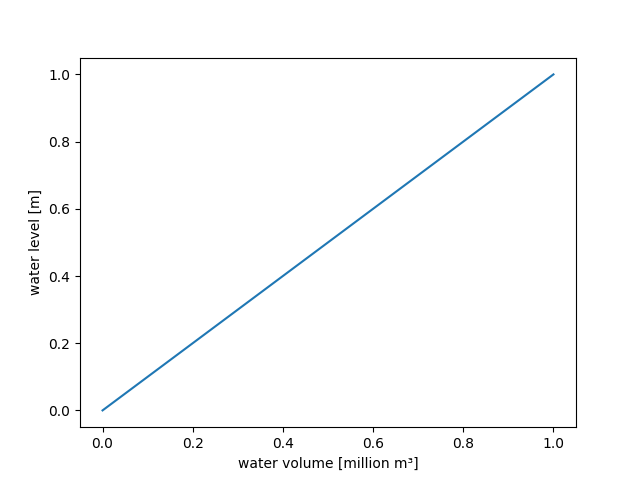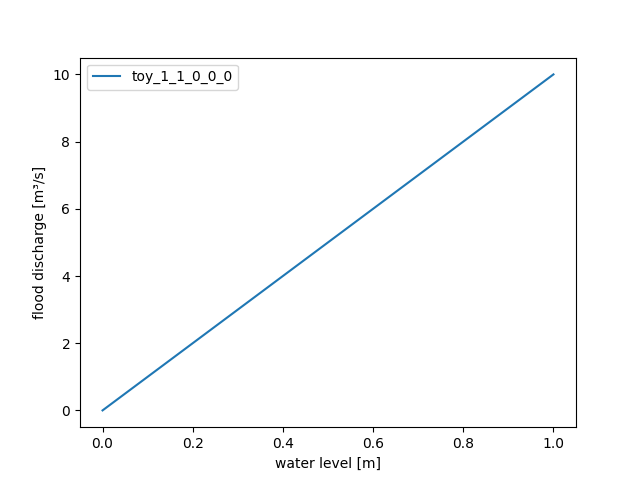dam_v006¶
Controlled lake version of HydPy-Dam.
Conceptionally, dam_v006 is similar to the “controlled lake” model of
LARSIM (selectable via the “SEEG” option). It simulates flood retention
processes only and neglects losses due to evaporation.
One can regard dam_v006 as controlled in two ways. First, it allows
for seasonal modifications of the rating curve via parameter
WaterLevel2FloodDischarge; second, it allows to restrict the speed of
the water level decrease during periods with little inflow via parameter
AllowedWaterLevelDrop.
Like all models of the HydPy-D family, dam_v006 solves its underlying
continuous ordinary differential equations with an error-adaptive numerical
integration method. Hence, simulation speed, robustness, and accuracy
depend both on the configuration of the parameters of the model equations
and the underlying solver. We discuss these topics in more detail in the
documentation on the application model dam_v001. Before the first usage
of any HydPy-Dam model, you should at least read how to set proper
smoothing parameter values and how to configure the artificial neural
networks used to model the relationships between stage and volume
(WaterVolume2WaterLevel) and between discharge and stage
(WaterLevel2FloodDischarge).
Integration tests¶
Note
When new to HydPy, consider reading section How to understand integration tests? first.
We are going to perform all example calculations over 20 days:
>>> from hydpy import pub
>>> pub.timegrids = "01.01.2000", "21.01.2000", "1d"
Now, we prepare a dam_v006 model instance in the usual manner:
>>> from hydpy.models.dam_v006 import *
>>> parameterstep("1d")
Next, we embed this model instance into an Element, being connected
to one inlet Node (input_) and one outlet Node (output):
>>> from hydpy import Element
>>> element = Element("element", inlets="input_", outlets="output")
>>> element.model = model
To execute the following examples conveniently, we prepare a test function object and change some of its default output settings:
>>> from hydpy import IntegrationTest
>>> IntegrationTest.plotting_options.axis1 = fluxes.inflow, fluxes.outflow
>>> IntegrationTest.plotting_options.axis2 = states.watervolume
>>> test = IntegrationTest(element)
>>> test.dateformat = "%d.%m."
WaterVolume is the only state sequence of dam_v006. We set its initial
value for each example to zero:
>>> test.inits = [(states.watervolume, 0.0)]
dam_v006 assumes the relationship between WaterLevel and WaterVolume
to be constant over time. To allow for maximum flexibility, it uses
parameter WaterVolume2WaterLevel, which extends the artificial neural
network parameter ANN. For simplicity, we enforce a linear
relationship between WaterLevel and WaterVolume (as shown in the
following graph):
>>> watervolume2waterlevel(
... weights_input=1.0, weights_output=1.0,
... intercepts_hidden=0.0, intercepts_output=0.0,
... activation=0)
>>> watervolume2waterlevel.plot(0.0, 1.0)
>>> from hydpy.core.testtools import save_autofig
>>> save_autofig("dam_v006_watervolume2waterlevel.png")

dam_v006 uses parameter WaterLevel2FloodDischarge (which extends
parameter SeasonalANN) to allow for annual changes in the
relationship between FloodDischarge and WaterLevel. Please read the
documentation on class SeasonalANN on how to model seasonal
patterns. Here, we again keep things as simple as possible and define
a single linear relationship which applies for the whole year:
>>> waterlevel2flooddischarge(ann(
... weights_input=1.0, weights_output=10.0,
... intercepts_hidden=0.0, intercepts_output=0.0,
... activation=0))
>>> waterlevel2flooddischarge.plot(0.0, 1.0)
>>> save_autofig("dam_v006_waterlevel2flooddischarge.png")

Additionally, we set the value of the related smoothing parameter
DischargeTolerance to 0.1 m³/s (this is a value we can recommend
for many cases – see the documentation on application model dam_v001
on how to fine-tune such smoothing parameter to your needs):
>>> dischargetolerance(0.1)
Finally, we define the ingoing flood wave, starting and ending with zero discharge:
>>> element.inlets.input_.sequences.sim.series = [
... 0.0, 1.0, 6.0, 12.0, 10.0, 6.0, 3.0, 2.0, 1.0, 0.0,
... 0.0, 0.0, 0.0, 0.0, 0.0, 0.0, 0.0, 0.0, 0.0, 0.0]
base scenario¶
For our first example, we set the AllowedWaterLevelDrop to inf,
to make sure this possible restriction does never affect the calculated
lake outflow:
>>> allowedwaterleveldrop(inf)
The only purpose of parameter CatchmentArea is to determine reasonable
default values for the parameter AbsErrorMax automatically, controlling
the accuracy of the numerical integration process:
>>> catchmentarea(86.4)
>>> from hydpy import round_
>>> round_(solver.abserrormax.INIT)
0.01
>>> parameters.update()
>>> solver.abserrormax
abserrormax(0.01)
The following test results show the expected storage retention pattern. The sums of inflow and outflow are nearly identical, and the maximum of the outflow graph intersects with the falling limb of the inflow graph:
>>> test("dam_v006_base_scenario")
Click to see the table
Click to see the graphdam_v006 achieves this sufficiently high accuracy with 174 calls to
its underlying system of differential equations, which averages to less
than nine calls per day:
>>> model.numvars.nmb_calls
174
low accuracy¶
Through increasing the numerical tolerance, e.g. setting AbsErrorMax
to 0.1 m³/s, we can gain some additional speedups without relevant
deteriorations of the results (dam_v006 usually achieves higher
accuracies than indicated by the actual tolerance value):
>>> model.numvars.nmb_calls = 0
>>> solver.abserrormax(0.1)
>>> test("dam_v006_low_accuracy")
Click to see the table
Click to see the graph>>> model.numvars.nmb_calls
104
water level drop¶
When setting AllowedWaterLevelDrop to 0.1 m/d, the resulting outflow
hydrograph shows a plateau in its falling limb. This plateau is placed in
the period where little inflow occurs, but the potential outflow
(FloodDischarge) is still high due to large amounts of stored water:
>>> allowedwaterleveldrop(0.1)
>>> solver.abserrormax(0.01)
>>> test("dam_v006_water_level_drop")
Click to see the table
Click to see the graph-
class
hydpy.models.dam_v006.Model[source]¶ Bases:
hydpy.core.modeltools.ELSModelVersion 6 of HydPy-Dam.
- The following “inlet update methods” are called in the given sequence at the beginning of each simulation step:
Pic_Inflow_V1Update the inlet link sequence.
- The following methods define the relevant components of a system of ODE equations (e.g. direct runoff):
Pic_Inflow_V1Update the inlet link sequence.Calc_WaterLevel_V1Determine the water level based on an artificial neural network describing the relationship between water level and water stage.Calc_SurfaceArea_V1Determine the surface area based on an artificial neural network describing the relationship between water level and water stage.Calc_FloodDischarge_V1Calculate the discharge during and after a flood event based on anSeasonalANNdescribing the relationship(s) between discharge and water stage.Calc_AllowedDischarge_V1Calculate the maximum discharge not leading to exceedance of the allowed water level drop.Calc_Outflow_V2Calculate the total outflow of the dam, taking the allowed water discharge into account.
- The following methods define the complete equations of an ODE system (e.g. change in storage of fast water due to effective precipitation and direct runoff):
Update_WaterVolume_V1Update the actual water volume.
- The following “outlet update methods” are called in the given sequence at the end of each simulation step:
Pass_Outflow_V1Update the outlet link sequenceQ.
- The following “additional methods” might be called by one or more of the other methods or are meant to be directly called by the user:
Fix_Min1_V1Apply functionsmooth_min1()without risking negative results.
-
numconsts: hydpy.core.modeltools.NumConstsELS¶
-
numvars: hydpy.core.modeltools.NumVarsELS¶
-
class
hydpy.models.dam_v006.AideSequences(master: hydpy.core.sequencetools.Sequences, cls_fastaccess: Optional[Type[FastAccessType]] = None, cymodel: Optional[hydpy.core.typingtools.CyModelProtocol] = None)¶ Bases:
hydpy.core.sequencetools.ModelSequences[AideSequence,hydpy.core.variabletools.FastAccess]Aide sequences of model dam_v006.
- The following classes are selected:
WaterLevel()Water level [m].SurfaceArea()Surface area [million m²].AllowedDischarge()Discharge threshold that should not be overcut by the actual discharge [m³/s].
-
class
hydpy.models.dam_v006.ControlParameters(master: hydpy.core.parametertools.Parameters, cls_fastaccess: Optional[Type[hydpy.core.parametertools.FastAccessParameter]] = None, cymodel: Optional[hydpy.core.typingtools.CyModelProtocol] = None)¶ Bases:
hydpy.core.variabletools.SubVariables[hydpy.core.parametertools.Parameters,Parameter,hydpy.core.parametertools.FastAccessParameter]Control parameters of model dam_v006.
- The following classes are selected:
CatchmentArea()Size of the catchment draining into the dam [km²].WaterVolume2WaterLevel()Artificial neural network describing the relationship between water level and water volume [-].WaterLevel2FloodDischarge()Artificial neural network describing the relationship between flood discharge and water volume [-].AllowedWaterLevelDrop()The highest allowed water level decrease [m/T].DischargeTolerance()Smoothing parameter for discharge related smoothing operations [m³/s].
-
class
hydpy.models.dam_v006.DerivedParameters(master: hydpy.core.parametertools.Parameters, cls_fastaccess: Optional[Type[hydpy.core.parametertools.FastAccessParameter]] = None, cymodel: Optional[hydpy.core.typingtools.CyModelProtocol] = None)¶ Bases:
hydpy.core.variabletools.SubVariables[hydpy.core.parametertools.Parameters,Parameter,hydpy.core.parametertools.FastAccessParameter]Derived parameters of model dam_v006.
- The following classes are selected:
TOY()References thetimeofyearindex array provided by the instance of classIndexeravailable in modulepub. [-].Seconds()Length of the actual simulation step size in seconds [s].DischargeSmoothPar()Smoothing parameter to be derived fromDischargeTolerancefor smoothing kernelssmooth_min1()andsmooth_max1()[m³/s].
-
class
hydpy.models.dam_v006.FluxSequences(master: hydpy.core.sequencetools.Sequences, cls_fastaccess: Optional[Type[FastAccessType]] = None, cymodel: Optional[hydpy.core.typingtools.CyModelProtocol] = None)¶ Bases:
hydpy.core.sequencetools.OutputSequences[FluxSequence]Flux sequences of model dam_v006.
- The following classes are selected:
Inflow()Total inflow [m³/s].FloodDischarge()Water release associated with flood events [m³/s].Outflow()Total outflow [m³/s].
-
class
hydpy.models.dam_v006.InletSequences(master: hydpy.core.sequencetools.Sequences, cls_fastaccess: Optional[Type[FastAccessType]] = None, cymodel: Optional[hydpy.core.typingtools.CyModelProtocol] = None)¶ Bases:
hydpy.core.sequencetools.LinkSequences[InletSequence]Inlet sequences of model dam_v006.
- The following classes are selected:
Q()Discharge [m³/s].
-
class
hydpy.models.dam_v006.OutletSequences(master: hydpy.core.sequencetools.Sequences, cls_fastaccess: Optional[Type[FastAccessType]] = None, cymodel: Optional[hydpy.core.typingtools.CyModelProtocol] = None)¶ Bases:
hydpy.core.sequencetools.LinkSequences[OutletSequence]Outlet sequences of model dam_v006.
- The following classes are selected:
Q()Discharge [m³/s].
-
class
hydpy.models.dam_v006.SolverParameters(master: hydpy.core.parametertools.Parameters, cls_fastaccess: Optional[Type[hydpy.core.parametertools.FastAccessParameter]] = None, cymodel: Optional[hydpy.core.typingtools.CyModelProtocol] = None)¶ Bases:
hydpy.core.variabletools.SubVariables[hydpy.core.parametertools.Parameters,Parameter,hydpy.core.parametertools.FastAccessParameter]Solver parameters of model dam_v006.
- The following classes are selected:
AbsErrorMax()Absolute numerical error tolerance [m3/s].RelErrorMax()Relative numerical error tolerance [1/T].RelDTMin()Smallest relative integration time step size allowed [-].RelDTMax()Largest relative integration time step size allowed [-].
-
class
hydpy.models.dam_v006.StateSequences(master: hydpy.core.sequencetools.Sequences, cls_fastaccess: Optional[Type[FastAccessType]] = None, cymodel: Optional[hydpy.core.typingtools.CyModelProtocol] = None)¶ Bases:
hydpy.core.sequencetools.OutputSequences[StateSequence]State sequences of model dam_v006.
- The following classes are selected:
WaterVolume()Water volume [million m³].
